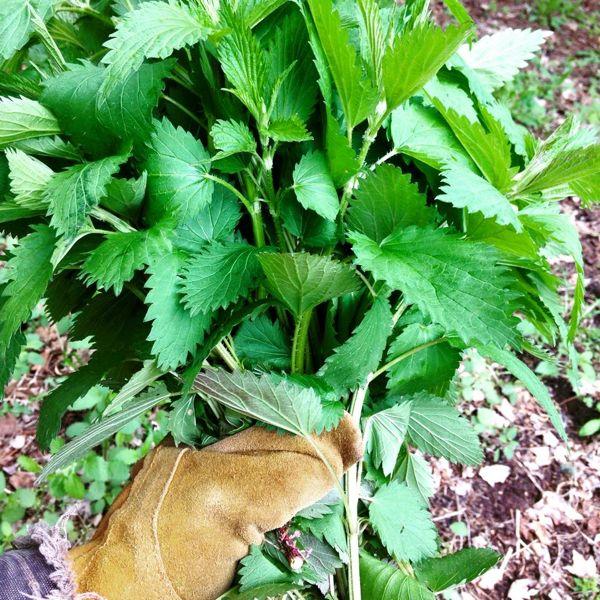Although there are numerous fresh herbs this time of year — and it's only going to get better from here until those first wintry flakes — what you find in your garden or farmers market is only part of the medicinal and culinary mix of options.
In other words, try eating some weeds.
What many people consider weeds could be the start of a beautiful herbal relationship. Once you start recognizing these once-reviled weeds, you'll begin to see your yard in a whole new way. Here are three that are often saved from my lawnmower's wrath, with many making their way into our dinners.
Nettles
Outstanding for allergies, nettles (sometimes called stinging nettles) are usually abundant in both urban and rural settings. Just when I was planning on going out to forage them in the woods, I realized I had some growing just under my flowering cherry tree.
Identify: Nettles can grow fairly tall — up to seven feet — and have sawtooth-type leaves that look a bit like lemon balm when they're small. The plant flowers annually with small greenish or brownish blooms.
Harvest: Take the leaves for drying, and keep the name in mind when harvesting. Once, I tried picking leaves without wearing gloves and the few stings I received made my hand throb for hours. Harvest in May or June, before the flowers appear.
Use: Dry the leaves and make into a tea. I drink this every spring to combat pollen allergies, and it works like a charm. The tea also boasts antioxidants, and can be made with fresh nettles. If adding to culinary dishes, steam the leaves briefly and include with other spring greens.

Dandelion
If there's one weed that seems to be the most combatted, and yet the most resilient, it's the humble dandelion. Although the scourge of lawn-loving homeowners everywhere, the dandelion is rich in beta-carotene, vitamin C, and numerous minerals. It boasts more protein than spinach, and has been used for thousands of years to treat anemia, depression, skin issues, and scurvy.
Identify: You're kidding, right? But just in case you've never seen one, dandelions have long, spiked leaves and cheerful, bright yellow flowers on a single stalk. When they bolt, the flowers turn into white globes of fluffy seeds that float toward whatever neighbor resents you the most.
Harvest: Every part of the plant is edible, so you can pick leaves, blooms, stems, and even roots. They tend to have a bitter flavor in mid-summer, so minimize that taste by harvesting in spring or fall.
Use: Dandelion greens are delicious when lightly braised with butter, or included raw in a salads. The leaves can be dried and made into tea, and the flowers make a nice edible flower in a dish like risotto.

Lambs quarters
With its jagged leaves and slender stalks, lambs quarters tend to get passed by because they're so abundant, and have a "weedy" look to them. But this relative to spinach and beets is packed with vitamins and minerals and has been used to address digestion issues and stomachaches.
Identify: With a slightly white coating on the leaves, lambs quarters often looks dusty at first glance. When mature, the plant has tiny green flowers that cluster on top.
Harvest: Pick off leaves, or cut the stems so you get several leaves. Seeds and flowers are also edible. Make sure the area where you're harvesting is known to be uncontaminated; lambs quarters often appear on toxic soil, as nature's way of attempting to restore nutrients.
Use: For most of the early summer, we throw lambs quarters into salads, or lightly sauté the green in coconut oil to put on top of tacos. The plant has an earthy taste, similar to collards, but with a slightly lemony undertone.
When harvesting non-cultivated herbs — also known as wildcrafting or foraging — it's likely that your adventurous spirit might take you outside of your backyard, and into forests, prairies, parks, and other habitats. I applaud any sense of exploration, but please keep sustainability in mind when you're doing any foraging. Some herbs become so popular that they get very overpicked, and then become endangered, or enthusiasts uproot the plant while harvesting, leaving whole patches of herbs unable to survive.
Responsible foragers take only the flowers, leaves, or fruit that they're going to use, and leave the majority of the plant undisturbed. If you want to replant what you're taking in your own garden, try to take only the smallest amount of rootstock needed, or use seeds from the plant to place into the empty hole left behind. In general, though, foraging in a way that lets the area seem undisturbed is the best, and most responsible, way to harvest wild herbs.

Elizabeth Millard is editor of Simple, Good and Tasty. She and her partner, Karla Pankow, run an organic farm, Bossy Acres, in northern Minnesota.

